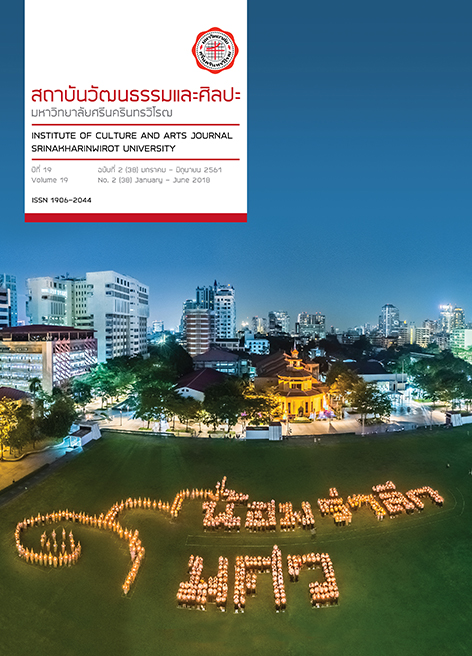The study of local literature related to the name of silk cloth stripes in amphoe Pak Thong Chai Nakhon Ratchasima province
Keywords:
silk culture, Pak Thong Chai’s silk, narratives on textureAbstract
The research aims to study origins and types of textures on silk in Pak Thong Chai, Nakhon Ratchasima and aims to analyze folk literary works reflected by textures especially oral literary works related to naming of silk textures.
The methodology used in the research is in-depth 6-months interview from 13 informants.These informants are 40-years-old silk weavers in 3 districts: Takhu, Muang Pak and Tongchai Neau. The acquired information is analyzed by qualitative research method and the validity of the analysis is verified by triangulation test.
Results from the study reveals that silk textures have 2 origins:
First, silk textures are descended from ancestors through learning processes in family and society. Informants in this groups are originally silk weavers since their ancestors’ period. In other words, these informants have experience on weaving since their childhood. Thus, they have acquired knowledge in both direct and indirect ways. For Pak Thong Chai people, silk texture creation is mainly caused by 2 factors. First, silk texture creation is made-to-order, Second, silk texture creation is inspired by their interest and imagination.
Second, silk textures are newly created. These are inspired by nature and man-made environments, imagination, and mass media. The main purpose of this creation is to increase creator’s self-identity, to participate silk competition, to attract customers and to increase silk value.
In terms of texture types, the study shows that texture can be categorized into 5 types by origin criterion: animal textures, plant textures, appliance textures, phenomenon textures. Also, the textures that weavers themselves creates in order to create their own identity.
In terms of silk textures’ name and local literary works, the study shows that silk textures’ names are related to local literary works in narrative genre. Weavers are narrators who gives the textures’ name. In other words, stories of textures’ origin do not derive from any other narrator.
Downloads
References
กิตติกรณ์ นพอุดมพันธุ์ (2559). วารสารสถาบันวัฒนธรรมและศิลปะ. ปีที่ 17 ฉบับที่ 2 (34) มกราคม –
มิถุนายน 2559. กรุงเทพฯ : มหาวิทยาลัยศรีนครินทรวิโรฒ
พิรุณรัตน์ เขตจัตุรัส. (2547). การศึกษาวรรณกรรมพื้นบ้านที่มีความสัมพันธ์กับชื่อลายผ้ามัดหมี่ของบ้าน
หนองบัวเพวัง อำเภอคอนสวรรค์ จังหวัดชัยภูมิ ในเชิงคติชนวิทยา. ปริญญานิพนธ์ การศึกษา
มหาบัณฑิต สาขาวิชาภาษาไทย (กศ.ม). กรุงเทพฯ : บัณฑิตวิทยาลัย มหาวิทยาลัยศรีนครินทรวิโรฒ
Downloads
Published
How to Cite
Issue
Section
License
บทความทุกบทความที่ได้รับการตีพิมพ์ถือเป็นลิขสิทธิ์ของวารสารสถาบันวัฒนธรรมและศิลปะ มหาวิทยาลัยศรีนครินทรวิโรฒ


